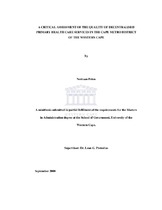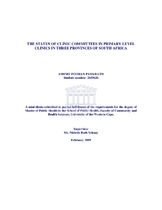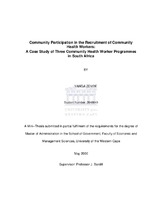| dc.description.abstract | Background:The Project reported on in this thesis took place between 2003 and 2006 and focused on the problem of high rates of low birth weight in the West Coast /Winelands area of the Western Cape Province, South Africa. A 32 page
woman’s health handbook (WHH) was developed and field-tested using a
participatory action research approach. The purpose of the WHH was to provide a health promotion tool that would increase the likelihood of satisfactory birth outcomes in future by: improving the continuity of care for women, especially in pregnancy; improving the interaction between health service providers and women during health consultations; and enabling women to improve their broader health literacy.Methods:The Project used both qualitative and quantitative methods and was carried out in three phases following steps in strategic communication development: situational and audience analysis; strategic design and development; and,field testing. The process involved three levels of stakeholders, or audiences: primary (women working on farms); secondary (local health service providers); tertiary (regional and provincial health department officials).Phase I began with a situational analysis of the two research sites in 2003 - Vredendal and Stellenbosch areas. Data was collected through key informant interviews, secondary data and general observations. The information on the two sub-districts was summarised. In order to understand the lifestyle and contextual issues facing the primary audience focus group discussions and key informant interviews with all three levels of the audience were carried out in 2004. The analysis utilised an inductive approach to generate themes that integrated the information from all sources and a framework for understanding substance use was developed. Ideas for the format and contents of the WHH were collected utilising the same methods and were summarised into
categories.Phase II utilised the findings of Phase I to develop the first version of the
WHH. This was pre-tested with all levels of the audience in individual interviews or focus groups to assess its accessibility, contents and appropriateness. The findings were used to prepare the second version of the WHH for Phase III.In Phase III the second version of the WHH was tested by recruiting a cohort of 103 participants who were utilising the antenatal clinic services in the two sites in 2005. A pre- and post-intervention questionnaire was used to collect qualitative and quantitative data to characterise the participants and, assess if the WHH that was given to them to keep had influenced their health knowledge and substance use behaviour. Analysis included simple frequencies, and a comparison of key outcome measures from the pre- and post-intervention questionnaires. Secondary level audience representatives were also interviewed, and content analysis carried out to identify theirperceptions of the WHH and any potential barriers to its future use in the
clinics. A final version of the WHH was developed and 10 000 copies made
available through a resource centre. The dissemination of a batch of the final
version was followed up in 2006.Results:The first phase identified the extent to which environmental and health-related behaviour contributed to low birth weight, as well as, other negative consequences in the lives of the primary audience. Important factors noted included the resource poor and stressful environment in which farm-based women live and work, and the high rates of women smoking cigarettes and drinking alcohol in general, and through pregnancy.A first version of the WHH was developed and pre-tested in the second phase by applying principles of designing health education materials for audiences with mid to low literacy levels. Results from this stage led to the development of the second version of the WHH.Although the evaluation of the second version of the WHH did not show any
significant change in the health knowledge of the participants on the pre- and
post-test analysis, there was a reduction in the use of alcohol, and very positive feedback on utilisation issues from all audiences. There was widespread dissemination of the final version of the WHH, however, neither the provincial nor the regional health authorities had incorporated it into their annual health promotion plan or budget.Conclusion:The participatory action research approach in the development of the WHH ensured that the form and contents was appropriate for most of the primary audience and that the secondary and tertiary audiences were supportive of its potential to positively women’s health in the region in the future. The main factors that limited the impact of the WHH include the need for the health service providers to consistently practice interactive health consultations using the WHH, and the need for the reproduction and dissemination of the WHH to
be led by the provincial health department.It is recommended that brief training of health service workers is required in order to ensure that the final version of the WHH is utilised to its full potential and, that the provincial and regional health authorities devise a reproduction and dissemination plan to ensure that all women using the public health services receive their own copy of the WHH. | en_US |




